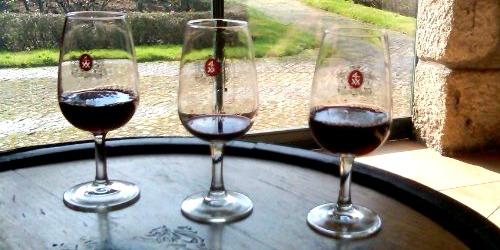 Porto (or Oporto) is the home of port wine. In the early 1700′s England was at war with France and so the people of England (longing for the delicious wine of France) searched for an alternative. They discovered the wines of Portugal, but quickly realized that the wine was spoiling before it made the long trip from Portugal to England. So the clever Brits devised a method of fortifying the wine to increase its longevity.
Porto (or Oporto) is the home of port wine. In the early 1700′s England was at war with France and so the people of England (longing for the delicious wine of France) searched for an alternative. They discovered the wines of Portugal, but quickly realized that the wine was spoiling before it made the long trip from Portugal to England. So the clever Brits devised a method of fortifying the wine to increase its longevity.
They added a neutral grape spirit, called aguardente, which stops fermentation and keeps more of the natural sugar intact. The wines are then aged in barrels (or bottles depending on the style ). Now we have white port, ruby port, tawny port, late bottled vintage, colheita, blends, and vintage port.
In the early days of the port industry, the grapes were grown in the Douro and then sent to Porto to be made into wine and aged in the city’s cellars, which are called caves. This was all done in Porto so that the finished product could be easily shipped the short distance down the river to the Atlantic and then on to England. Now, while the grapes are still grown in the Douro Valley, the rest of the process is completed there as well, leaving many of Porto’s wine caves just for show or to welcome people who want to come taste the port wine. In fact, port tasting is the main activity in Porto and one you should not skip.
The port houses of Porto aren’t actually in Porto. They’re across the river (a 5-10 minute walk) in Vila Nova de Gaia. Just over the iron-trellised Ponte Luís I bridge (which may look familiar in style, as it was made by a partner of Eiffel) there are over a dozen port houses that open their doors for free or low-cost tasting.
My advice is to start at the top of the hill and work your way down. Like Porto, Vila Nova de Gaia is quite hilly, and steep cobblestone streets become more difficult to navigate after a few glasses of port. And be sure to eat before you go, as there are only a handle of dining options on this side and most are down by the riverfront. There are signs and arrows throughout the town pointing you to nearby port houses (most hotels have a map as well) from the more touristy Sandeman (which does have an excellent cafe attached for a quick snack), to the famous Taylor’s and Graham’s. I preferred the lesser-known (and still Portuguese owned) Wiese and Krohn (where we were the only people on the tour – as compared to Sandeman’s sold-out tour of more than 30 people!), Burmester, and Kopke.
 Some, like Croft, Wiese and Krohn, and Taylor’s, offer free tours. On the tours, which last about 10-30 minutes, you’ll learn more about the history of port and how it is made. Sandeman and a few others change a small fee for the tour and tasting. And still others, like Kopke, just have tasting rooms with no tours.
Some, like Croft, Wiese and Krohn, and Taylor’s, offer free tours. On the tours, which last about 10-30 minutes, you’ll learn more about the history of port and how it is made. Sandeman and a few others change a small fee for the tour and tasting. And still others, like Kopke, just have tasting rooms with no tours.
Though there is no tour at Kopke, I highly recommend visiting this oldest port house. You have to pay for samples, which you can try by the glass or flight paired with chocolates. Tastes range from 1-3 euros on up to 8-15 (and much, much higher) depending on the age and style. I recommend going with a flight; I enjoyed two Portuguese wines and three port wines with accompanying chocolates for just 13 euros. If you’d rather not schlep from port house to port house and don’t mind paying for tastes, head to the Port Wine Institute. Here, overlooking the Douro River on the Porto side, you can sample from hundreds of ports starting at 1 euro per glass.
For more port wine fun, you can book a day cruise down the Douro to see where the grapes are grown (some tours also include a stop at one winery). And if you want the wine theme to carry over into your hotel, stay at The Yeatman Hotel, in Vila Nova de Gaia side, where wine themed rooms with private patios are just steps away from the port caves.
>> Read more about the Yeatman
Photos by: Katie Hammel , rene j,